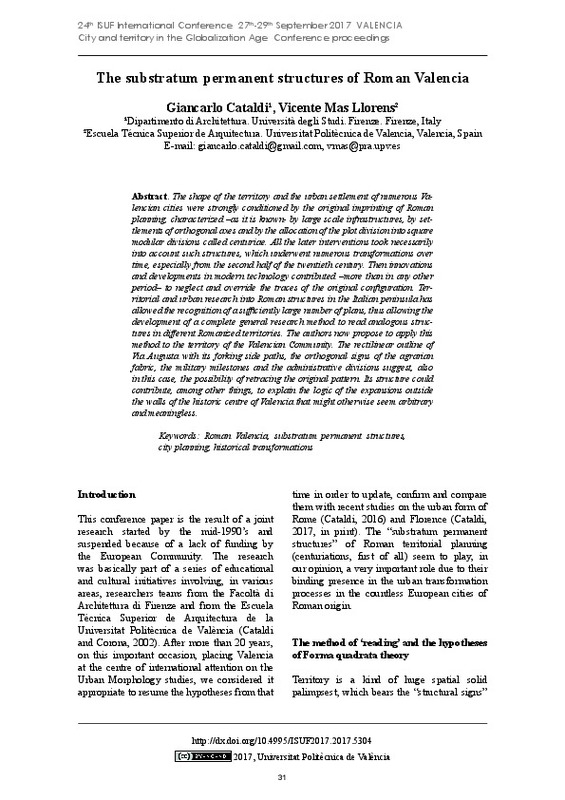JavaScript is disabled for your browser. Some features of this site may not work without it.
Buscar en RiuNet
Listar
Mi cuenta
Estadísticas
Ayuda RiuNet
Admin. UPV
Valencia: the territorial structures of the Roman city substratum
Mostrar el registro sencillo del ítem
Ficheros en el ítem
| dc.contributor.author | Cataldi, Giancarlo
|
es_ES |
| dc.contributor.author | Mas Llorens, Vicente
|
es_ES |
| dc.coverage.spatial | east=-0.3762881000000107; north=39.4699075; name=Valencia, Espanya | es_ES |
| dc.date.accessioned | 2018-12-27T07:13:40Z | |
| dc.date.available | 2018-12-27T07:13:40Z | |
| dc.date.issued | 2018-04-20 | |
| dc.identifier.isbn | 9788490485743 | |
| dc.identifier.uri | http://hdl.handle.net/10251/114483 | |
| dc.description.abstract | [EN] The shape of the territory and the urban settlement of numerous Valencian cities were strongly conditioned by the original imprinting of Roman planning, characterized –as it is known- by large scale infrastructures, by settlements of orthogonal axes and by the allocation of the plot division into square modular divisions called centuriae. All the later interventions took necessarily into account such structures, which underwent numerous transformations over time, especially from the second half of the twentieth century. Then innovations and developments in modern technology contributed –more than in any other period– to neglect and override the traces of the original configuration. Territorial and urban research into Roman structures in the Italian peninsula has allowed the recognition of a sufficiently large number of plans, thus allowing the development of a complete general research method to read analogous structures in different Romanized territories. The authors now propose to apply this method to the territory of the Valencian Community. The rectilinear outline of Via Augusta with its forking side paths, the orthogonal signs of the agrarian fabric, the military milestones and the administrative divisions suggest, also in this case, the possibility of retracing the original pattern. Its structure could contribute, among other things, to explain the logic of the expansions outside the walls of the historic centre of Valencia that might otherwise seem arbitrary and meaningless. | es_ES |
| dc.format.extent | 7 | es_ES |
| dc.language | Inglés | es_ES |
| dc.publisher | Editorial Universitat Politècnica de València | es_ES |
| dc.relation.ispartof | 24th ISUF International Conference. Book of Papers | es_ES |
| dc.rights | Reconocimiento - No comercial - Sin obra derivada (by-nc-nd) | es_ES |
| dc.subject | Roman Valencia | es_ES |
| dc.subject | Substratum permanent structures | es_ES |
| dc.subject | City planning | es_ES |
| dc.subject | Historical transformations | es_ES |
| dc.title | Valencia: the territorial structures of the Roman city substratum | es_ES |
| dc.type | Capítulo de libro | es_ES |
| dc.type | Comunicación en congreso | es_ES |
| dc.identifier.doi | 10.4995/ISUF2017.2017.5304 | |
| dc.rights.accessRights | Abierto | es_ES |
| dc.description.bibliographicCitation | Cataldi, G.; Mas Llorens, V. (2018). Valencia: the territorial structures of the Roman city substratum. En 24th ISUF International Conference. Book of Papers. Editorial Universitat Politècnica de València. 31-37. https://doi.org/10.4995/ISUF2017.2017.5304 | es_ES |
| dc.description.accrualMethod | OCS | es_ES |
| dc.relation.conferencename | 24th ISUF 2017 - City and Territory in the Globalization Age | es_ES |
| dc.relation.conferencedate | Septiembre 27-29,2017 | es_ES |
| dc.relation.conferenceplace | Valencia, Spain | es_ES |
| dc.relation.publisherversion | http://ocs.editorial.upv.es/index.php/ISUF/ISUF2017/paper/view/5304 | es_ES |
| dc.description.upvformatpinicio | 31 | es_ES |
| dc.description.upvformatpfin | 37 | es_ES |
| dc.type.version | info:eu-repo/semantics/publishedVersion | es_ES |
| dc.relation.pasarela | OCS\5304 | es_ES |








